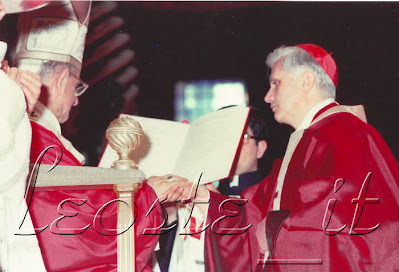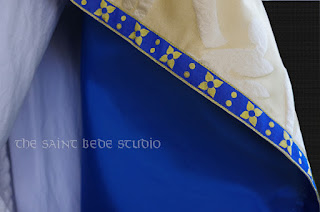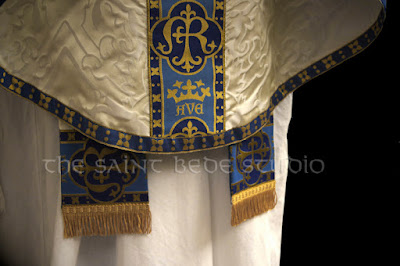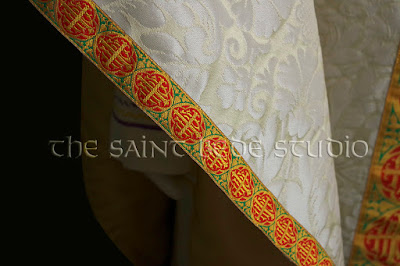On 19th April, 2005,
JOSEPH ALOISIUS RATZINGER, Cardinal-Dean of the Sacred College of Cardinals,
was elected Pope by 115 members of the College and took the name Benedict, recalling his World War One predecessor. His election had been hoped for by many, but thought unlikely because of his advanced age. Following the reign of a Polish Pope, the election of a German Pope closed the circle of the experience of World War Two.
Joseph Ratzinger was born in the town of Marktl am Inn, Germany on 16th April 1927. From a staunch Catholic family, the Nazi regime drafted him into military service when he was 16, but he deserted the Army shortly before the end of the European war. Commencing studies for the priesthood after the war, he was ordained in 1951, but continued as a scholar, teacher and writer at various German Universities. He was a peritus at the Second Vatican Council where his views were seen as progressive. In 1977, he was appointed archbishop of Munich and Freising and was created a Cardinal in the last Consistory of Pope Paul VI in June 1977. After a few years, Pope John Paul II brought the scholarly Cardinal to Rome and the two worked together in great harmony and personal friendship until the death of the Pope in 2005.
Benedict XVI was a gracious and prudent man. He was also a man of deep learning and the author of many books. His was the greatest intellect of any Pope in modern history, even considering that of his immediate predecessor John Paul II. At an advanced age and in poor health, Pope Benedict made the startling decision to Renounce the Petrine Office in February 2013 and live in retirement in a small residence in the Vatican Gardens. Making some appearances in these years of retirement, such that he was never forgotten, he died as a much-beloved grandfather of the Church on 31st December, 2022 and is buried in the crypt of Saint Peter's Basilica.
A useful but not exhaustive summary of his life may be found here.
Please click on the images for an enlarged view.
 |
The adjacent photograph was taken at the Mass of the Rings
in Saint Peter's, following Joseph Ratzinger's creation as
a Cardinal-priest in 1977 by Pope Paul VI.
At this time, Cardinal Ratzinger was Archbishop of Munich. |
 |
Good Friday 2004.
When John Paul had become too infirm to offer Mass publicly,
he was frequently assisted by his friend,
the Dean of the College of Cardinals,
Joseph Cardinal Ratzinger.
|
In the first two years or so of the Pontificate of Pope Benedict, a whole new range of Papal vestments was introduced by the then Prefect of Pontifical Ceremonies, Monsignor Piero Marini.
 |
Pope Benedicit
during a Lenten liturgy 2006 |
 |
An unusual purple cope
worn by Pope Benedict for Vespers
Advent 2006. |
 |
This beautiful straw-gold cope and mitre
matched a set of Eucharistic vestments
previously used by John Paul II. |
The photograph below depicts Pope Benedict during Vespers at the Basilica of Saint Paul's-Without-the-Walls on the Feast of Saints Peter and Paul. This magnificent cope - which had matching dalmatics - was recently worn by the Cardinal-Camerlengo when the remains of the late Pope were brought solemnly into Saint Peter's Basilica.
After Monsignor Guido Marini was appointed Papal Master of Ceremonies in 2007, there was an increased use by Pope Benedict of historic chasubles, copes and mitres from the Papal Treasury. In the following two photographs, we feature two such mitres.
The first mitre was made for Pope Piux IX (1846 - 1878) to coincide with the promulgation of the Definition of the Immaculate Conception in 1854. The mitre features pictorial embroideries of the Blessed Virgin and the Christ the Good Shepherd. The mitre had subsequently been used by Pope John Paul II. A little known fact about Pius IX is that he did not favour very tall mitres, but something more proportionate.
 |
| Mitre of Pope Pius IX |
The second mitre was made for Pope Benedict XV (1914-1922) and which was subsequently used by Pius XII, John XXIII and Paul VI. This splendid jewelled mitre preserves the traditional form for the ornamentation of a mitre: the
circulus and
titulus, namely those bands of ornament running around the head and vertically up the centre of the mitre. Unhappily, many baroque mitres abandoned this ancient ornament in favour of something far less tasteful.
 |
| Mitre of Pope Benedict XV. |
During a visit to Venice, Benedict XVI was presented with a magnificent chasuble set with matching mitre. The vestments were inspired by mediaeval originals, although in a modern interpretation. In 2012, Pope Benedict wore these vestments again, but this time also using the Papal
Fanon: a distinctive shoulder cape reserved solely to the use of the Supreme Pontiff.
 |
| Pope Benedict wearing the Papal Fanon 2012. |
The photograph below depicts a remarkable set of vestments, made from a reproduction of a Renaissance damask, which was used in the venerable Basilica of Santa Sabina on Ash Wednesday 2009. Matching dalmatics are also shewn.
Being a Penitential day, the Pope wore the
mitra simplex with these vestments. It is believed that the late Pope was vested in this mitre (or one identical with it) for his laying-in-state and burial.
 |
Pope Benedict imposing the ashes
Santa Sabina 2009. |
On the occasion of his visit to the Benedictine Abbey of Monte Cassino in May 2009, the late Pope Benedict was presented with sets of vestments. The presentation consisted of a chasuble, mitre, cope and matching dalmatics. In their ornamentation, these vestments are very much in the character of the style of vestments used in Italy in the 13th century, although the cut of the chasuble is Borromeon. Concerning the mitre, it was made from a white silk damask and its orphrey (properly called the
circulus and
titulus)
is also formed from hand-embroidered gold silk.
 |
| Candlemas at Saint Peter's February 2013 |
 |
Epiphany 2010:
This is the chasuble in which Ss. John XXIII
& Paul VI were crowned as Pope.
On a man of the stature and build of Pope Benedict these chasubles,
cut in the Roman style of the 18th century,
usually looked dignified and rich. |
After 2007, there was an increased use by Pope Benedict of historic chasubles, copes and mitres from the Papal Treasury. In the photograph below is depicted a famous cope, which made for Pope S. John XXIII.
The Papal Cope was formerly a very long garment, trailing upon the ground. It was called the
mantum. The mantum of S. John XXIII was worn at the Solemn Opening of the Second Vatican Council in 1962. It was also used during the early years of the reign of Pope Paul VI.
The cope is made of white silk interwoven with threads of spun gold. It is also embroidered with gold bullion. The photograph clearly shew the coat of arms of S. John XXIII. It appears that the
mantum was shortened at some stage, since it no longer falls in folds upon the ground.
In Saint Mary’s Cathedral, Sydney, on Saturday 19th July 2008, Pope Benedict celebrated Pontifical Mass with the Australian Bishops for seminarians and religious novices. This was part of the Pope's three-day visit to Australia on the occasion of World Youth Day.
The vestments and mitre worn by Pope Benedict for this Papal Mass, together with the dalmatics of the deacons-assistant were designed and made by the Saint Bede Studio, by the commission of the Archdiocese of Sydney and the Holy See. They are now kept in the Papal Sacristy of Saint Peter's Basilica.
 |
Pope Benedict is greeted by a Religious Sister
after an Address of Welcome. |
AMDG




























.jpg)
























